#nasa/jpl-caltech/ucla
Explore tagged Tumblr posts
Text

Soul Nebula
(Image credit: NASA/JPL-Caltech/UCLA)
78 notes
·
View notes
Text
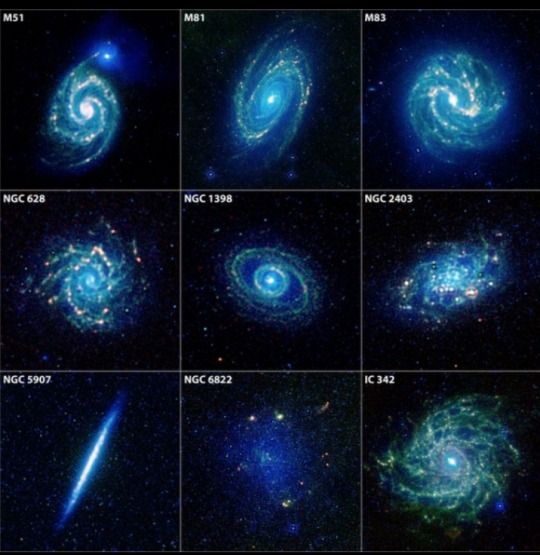
Incredible: The galaxies in our universe are as diverse as snowflakes. ❄️
Credit: NASA / JPL-Caltech / UCLA
58 notes
·
View notes
Text
Seven sisters become wise
Siete hermanas se vuelven sabias Esta imagen muestra el famoso cúmulo de estrellas de las Pléyades tal como se ve a través de los ojos de WISE, o Wide-field Infrared Survey Explorer de la NASA A una distancia de unos 436 años luz de la Tierra, las Pléyades es uno de los cúmulos de estrellas más cercanos y juega un papel importante en la determinación de las distancias a los cuerpos astronómicos…

View On WordPress
0 notes
Photo

An Unusual Mountain on Asteroid Ceres
Credits: NASA, JPL-Caltech, UCLA
71 notes
·
View notes
Photo

Ceres!
A mosaic image from NASA's Dawn spacecraft uses false color to highlight the recently exposed brine, or salty liquids, that were pushed up from a deep reservoir under Ceres' crust. In this view of a region of Occator Crater, they appear reddish.
Credit: NASA / JPL-Caltech / UCLA / MPS / DLR / IDA
#art#photography#mosaic#cosmos#cosmic#universe#ceres#nasa#spacecraft#dawn spacecraft#liquid#occator crater#jpl-caltech#UCLA#MPS#DLR#IDA#cosmos wallpaper#ceres wallpaper
6 notes
·
View notes
Text

M33
48 notes
·
View notes
Photo

The bright spots on Ceres still pose a mystery on how they may have formed and what this implies for the formation of geologically interesting locations in the Solar System such as the largest asteroid; (1) #Ceres. Join us TODAY from 12-1PM for our @UCLA EPSS Planet Lunch Seminar talk on how the bright spots may have formed with a talk by Nathan Stein from Caltech (@Caltechedu) with his talk title: "The formation and timing of near-subsurface Na-carbonate deposits on Ceres". Image Credit: NASA/JPL-Caltech/UCLA #nasa #asteroid #Caltech #cosmos #education #interstellar #JPL #LA #Pasadena #physics #pizza #science #sky #solarsystem #space #STEM #UCLA #universetoday (at Institute for Planets & Exoplanets - IPLEX) https://www.instagram.com/p/BwKk4__HvTT/?utm_source=ig_tumblr_share&igshid=4wezlnzdrfws
#ceres#nasa#asteroid#caltech#cosmos#education#interstellar#jpl#la#pasadena#physics#pizza#science#sky#solarsystem#space#stem#ucla#universetoday
3 notes
·
View notes
Photo

Mapping the Entire Night Sky by NASA's Marshall Space Flight Center This mosaic is composed of images covering the entire sky, taken by the Wide-field Infrared Survey Explorer (WISE) as part of WISE's 2012 All-Sky Data Release. By observing the entire sky, WISE could search for faint objects, like distant galaxies, or survey groups of cosmic objects. Not visible to the human eye, infrared light is radiated by a plethora of cosmic objects, including cool, nearby stars and some of the most luminous galaxies in the universe. The WISE mission ended in 2011 after the onboard coolant – needed for some infrared observations – ran out, but the spacecraft and some of its infrared detectors were still functional. So, in 2013, NASA repurposed it to track asteroids and other near-Earth objects, or NEOs. Both the mission and the spacecraft received a new name: NEOWISE. Image Credit: NASA/JPL-Caltech/UCLA #NASA #NASAMarshall #universe #NEOWISE #WISE #stars #BlackHoles #sky #astrophotography #research #science #JPL Read more More about NASA's Wide-field Infrared Survey Explorer (WISE) NASA Media Usage Guidelines https://flic.kr/p/2nWAmiT
38 notes
·
View notes
Text
4 Vesta
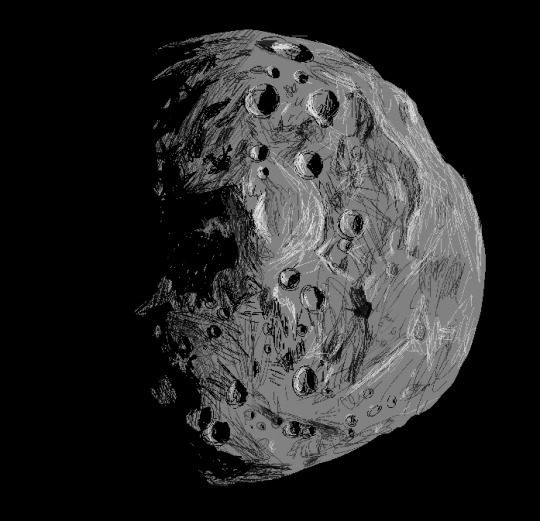
Here is 4 Vesta, the second largest planet in the Asteroid Belt between Mars & Jupiter. In this sketch, based on a photo imaged by the Dawn spacecraft in July 2011, we’re looking down on the Rheasilvia basin on Vesta’s south pole. An impact event one billion years ago blasted out one of the Solar System’s largest craters, and the rebound from the blast produced perhaps the Solar System’s largest mountain--slightly taller than Olympus Mons on Mars. The debris from that impact produced 15,000 or so smaller asteroids which share a similar orbit, and many stony meteorites are thought to trace back to this impact event as well.
Can’t see the basin? Because it’s so large, it’s quite subtle and shallow. At 500 kilometers across, its diameter is 87% that of Vesta itself. Almost hilariously, Rheasilvia is covering up another basin which is nearly as large, the Veneneia basin. Over 50% of Veneneia is covered by Rheasilvia. Veneneia is between 2 and 4.2 Billion years old, is 395 kilometers across, 70% the diameter of Vesta, and can be barely seen slightly below Rheasilvia in this image.
You’ll notice at the beginning of this post I called Vesta a planet. Perhaps the term “Planetoid,” “Asteroid,” or “Minor Planet” would be more suitable, but the truth is that for the most part planetary scientists do not differentiate between planet, dwarf planet, asteroid, satellite, etc.* Vesta has a lot of planet-like properties--it’s got an iron-nickel core, a rocky mantle, and a distinct crust. It even seems to have tectonic activity, like the Moon and Mercury. Only about four or five asteroids are internally differentiated this way. Vesta would count as a “dwarf planet” at least, were it not for the Rheasilvia basin having been dredged out of it, preventing it from remaining rounded.
Reference photo and *spicy planet opinions under the cut.
*The number of planets in the solar system is basically arbitrary, and the notion of only 8 or 9 is much more recent than you’d think. After all, why are the satellite planets (as moons have long been called) not counted? Why are the gas giants and the terrestrial worlds grouped into the same collection? Depending upon how you define planet, the solar system could have four, eight, thirteen, 33-ish, several dozen, hundreds, or millions. Planet shouldn’t be a rigidly defined term, and as far as I can tell, planetary scientists generally do not agree with or use the 2006 IAU definition of a planet.
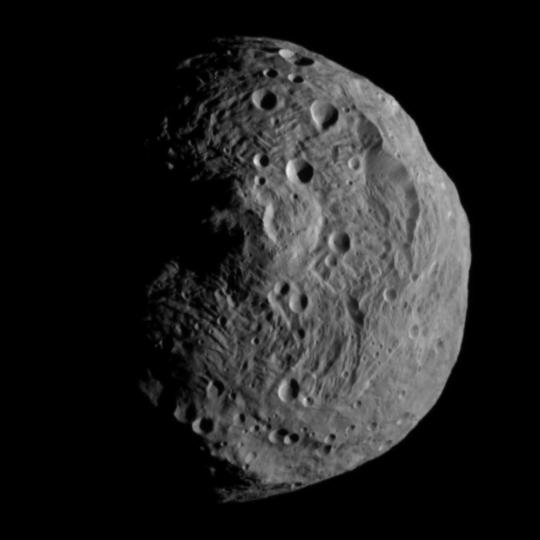
NASA/JPL-Caltech/UCLA/MPS/DLR/IDA
#Vesta#4 Vesta#asteroid#asteroid belt#planet#planetoid#minor planet#dwarf planet#sketch#space art#sci art#space
9 notes
·
View notes
Text
Ceres may have formed in the outer solar system
Ceres may have formed in the outer solar system
A map of Ceres’ northern hemisphere by the Dawn spacecraft’s Gamma Ray and Neutron Detector, GRaND. Credit: NASA/JPL-Caltech/UCLA/ASI/INAF Dwarf planet Ceres may be located in the asteroid belt between Mars and Jupiter, but its composition and large water content suggest it formed in the outer solar system where other dwarf planets orbit. (more…)

View On WordPress
2 notes
·
View notes
Photo

FIRST SUPERNOVA EVER RECORDED Chinese astronomers in 185AD recorded a ‘guest star’ that appeared in the sky and stayed for about 8 months. This object was identified in the 1960’s as the first documented supernova. RCW 86 is a supernova remnant located about 8,000 light-years away.
Infrared observations from NASA's Spitzer Space Telescope and Wide-field Infrared Survey Explorer, or WISE, reveal that the stellar explosion occurred in a hollowed out cavity, which meant material ejected by the star could travel much faster and expanded farther than it would have otherwise. It is two to three times bigger than what would be expected for a supernova which exploded nearly 2,000 years ago. The event is a Type Ia supernova, which is created by the death of a sun-like star. The star would have shrunk into a white dwarf (a dense star), and it is thought that this white dwarf exploded in a supernova after it siphoned material from a nearby star. The image combines data from four different space telescopes to create a multi-wavelength view of all that remains of RCW 86. -TEL http://www.spitzer.caltech.edu/news/1324-ssc2011-09-NASA-Telescopes-Help-Solve-Ancient-Supernova-Mystery https://www.space.com/17604-all-eyes-on-oldest-recorded-supernova.html Image credit: NASA/ESA/JPL-Caltech/UCLA/CXC/SAO
#supernova#rcw 86#nebula#white dwarf#space#telescope#physics#science#the universe#isuniverse#the real universe
62 notes
·
View notes
Text
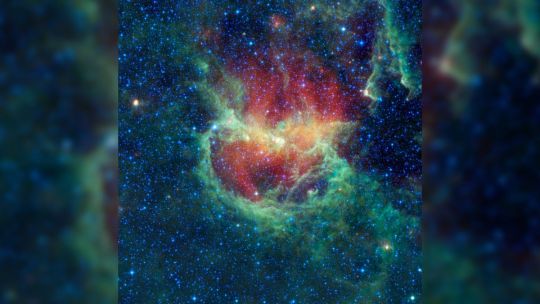
Running Chicken Nebula
(Image credit: NASA/JPL-Caltech/UCLA)
11 notes
·
View notes
Text
a full rotation of the asteroid Vesta as seen from the Dawn spacecraft in 2011
Credit...NASA-JPL-Caltech-UCLA-MPS-DLR-IDA Little Mountain 5
6 notes
·
View notes
Video
instagram
This is an awesome video showing Ceres. *** Ceres as you've never seen before. This video animation is based on images taken by NASA's Dawn spacecraft. The images provided information for a three-dimensional terrain model. The vertical dimension has been exaggerated by a factor of two, and a star field has been added in the background. Photos by NASA/JPL-Caltech/UCLA/MPS/DLR/IDA/ESO/S. Brunier. Processing, animation & music: DLR (F. Preusker, E. Kersten, S. Elgner). Check out our profiles around the Internet for more UFO videos and UFO photos: Join me on Facebook: https://www.facebook.com/ufosightings... Our websites at : https://www.ufonews.uk https://www.ufosfootage.uk https://www.ufosightingsfootage.uk @ufosightingsfootage @ufosfootage #ufosfootage #ufosightingsfootage #ufosfootages #ufonews 👽Tell a friend 👽turn on notifications 👽like and subscribe👽 (at Los Angeles, California) https://www.instagram.com/p/CVAqr3Aoaz-/?utm_medium=tumblr
1 note
·
View note
Photo
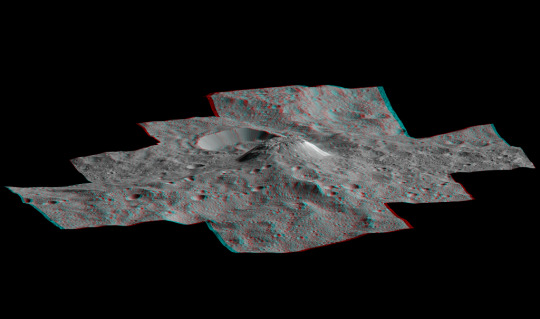
3D Ahuna Mons
Credits: NASA, JPL-Caltech, UCLA
18 notes
·
View notes
Video
youtube
2020 September 1
Salt Water Remnants on Ceres Video Credit: Dawn Mission, NASA, JPL-Caltech, UCLA, MPS/DLR/IDA
Explanation: Does Ceres have underground pockets of water? Ceres, the largest asteroid in the asteroid belt, was thought to be composed of rock and ice. At the same time, Ceres was known to have unusual bright spots on its surface. These bright spots were clearly imaged during Dawn's exciting approach in 2015. Analyses of Dawn images and spectra indicated that the bright spots arise from the residue of highly-reflective salt water that used to exist on Ceres' surface but evaporated. Recent analysis indicates that some of this water may have originated from deep inside Ceres, indicating Ceres to be a kindred spirit with several Solar System moons, also thought to harbor deep water pockets. The featured video shows in false-color pink the bright evaporated brine named Cerealia Facula in Occator Crater. In 2018, the mission-successful but fuel-depleted Dawn spacecraft was placed in a distant parking orbit, keeping it away from the Ceres' surface for at least 20 years to avoid interfering with any life that might there exist.
∞ Source: apod.nasa.gov/apod/ap200901.html
30 notes
·
View notes